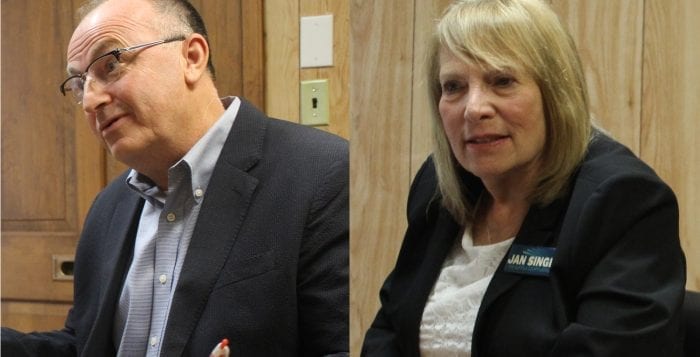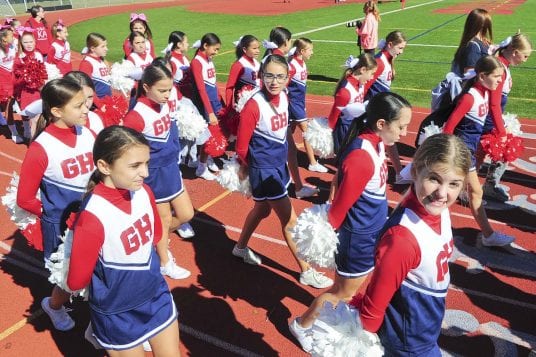The Times of Smithtown circulation area includes two Suffolk County legislative districts: 12 and 13. The 12th District encompasses Nesconset and Lake Grove and extends west through portions of St. James into Commack. The 13th District extends from Fort Salonga east to St. James.
Currently, two Republicans represent the areas, Leslie Kennedy and Robert Trotta, respectively. Overall, the Democrats with an 11-7 ratio, have a majority rule in the county, as it has for the last 13 years. Republicans held the majority for 33 years prior to that.
Many analysts say that this year’s election could potentially see a shift in power or perhaps tie the representation. So a lot is at stake.
District 13: Parts of Smithtown and St. James, Fort Salonga, San Remo, Kings Park, Nissequogue, Head of the Harbor, Commack and East Northport
By Leah Chiappino
Suffolk County Legislator Rob Trotta (R) is running for reelection. He has represented Suffolk’s 13th District since 2013. Jan Singer (D), a retired matrimonial lawyer, is challenging him for the seat in this year’s election.
Trotta, a former Suffolk County police officer for 25 years and FBI agent for 10 years, said his priorities include addressing high taxes, wasteful spending and weeding out county corruption.
Serving under a corrupt police chief, he said, prompted him to run for office six years ago. “I knew how corrupt the county was and I knew if I didn’t leave, I would get arrested, get in trouble, or die,” he said. “Of the three of us that were on the FBI task force, one is dead, one got arrested and I became a legislator.”
Personally, Trotta said that he has refused any campaign contributions from any person or organization that does business with the county. He supports legislation that would prevent lawmakers from voting on union contracts, if the union has contributed to a legislator’s campaign. Overall, these practices, he expects, would save money and prevent conflicts of interest.
“Everything comes from wasteful spending and corrupt politicians taking too much money,” he said.
Singer said her leadership experience will help to make needed changes for Suffolk. She operated a private law practice for over 30 years before retiring in 2012. She’s organized phone banks for Perry Gershon (D) and Hillary Clinton (D), served as president of her homeowner association, and sat on the board of the Suffolk County Girl Scouts and the Smithtown Democratic Committee. If elected, Singer’s priorities include addressing Suffolk County’s water quality issues.
“If we don’t have quality water, free of nitrogen, 1-4-dioxane, and chemical pollution, we can’t have anything,” she said. “We can’t have the economic development which is so necessary to making Suffolk County thrive, because businesses will not open and people will not buy homes.”
To address water quality, Trotta supports reallocating the county’s one-quarter percent (0.25) sales tax income for its Water Quality Protection and Restoration Program, so more general fund money is dedicated to protecting the county’s water.
Singer’s position to address climate change includes support for renewable energy initiatives such as wind turbines and solar energy and an increase in public transportation.
A major concern for both candidates is the county’s budget problems. New York State Comptroller Tom DiNapoli (D) monitors fiscal stress for the state’s municipalities. Suffolk County, according to the latest report, tops the list as the worst fiscal condition out of all counties.
“I wouldn’t be able to sleep at night knowing the debt we are putting on our children,” Trotta said.
He blames the county budget troubles on overspending. Government contracting, he said, should be more deeply scrutinized. Personnel costs and expenses, such as police overtime, large pensions and pay increases need to be reined in. As a former police officer, he says he understands the vital work the police do.
“I’m not saying they don’t deserve their money, but they don’t deserve to bankrupt the country and make it unaffordable for people to live here,” he said.
Singer takes a different stance.
“The police are the ones that run into danger when I run away,” she said. “They are the ones dealing with the opioid crisis and MS-13. If you go to doors, I have not heard people screaming about overtime and excess pay for the police. They want them there.”
To address the issue, Trotta prefers raising revenue through taxes, instead of hitting people with expenses such as mortgage filing fees, which recently jumped from $65 to $600. The fee is paid not only when people buy a home but also when they refinance their mortgage.
Singer is not for eliminating these fees.
“I’m not debating whether or not some of the fees such as the mortgage recording fees are too high, but I don’t disagree with the principle of having it because the alternative is to either discontinue the service, run the service at a reduced level, or raise taxes,” she said.
Both candidates see the opioid crisis as a critical issue. Singer proposes expanding education prevention services and supports an effort to expand medically assisted therapy and rehab programs in prisons. Any settlement funds that the county receives from its lawsuits against pharmaceutical companies, Singer said, should be used for treatment and education.
Trotta says the county “cannot arrest its way out” of the problem, noting that many people addicted to opioids also suffer from mental health conditions, such as anxiety and depression. He supports “treatment and a variety of different methods” to curb the issue.
With regard to the red-light camera ticketing program, Trotta calls it a money grab that causes more accidents than it prevents. He thinks it should be eliminated.
A study conducted by Brookhaven-based L.K. McLean Associates and released earlier this year, stated that accidents were up 60 percent since the program’s implementation, though accidents involving injuries went down by 11 percent.
“If someone runs a red light and it’s dangerous, they should get a ticket period,” Trotta said. “Unfortunately, that’s not what’s happening here.”
Singer supports continuing the program.
“It is about safety,” she said. “The vehicle and traffic law says you can’t run that red light.
Singer and Trotta both support the revitalization of Kings Park, and both agree that the community should retain its small-town feel.














































































